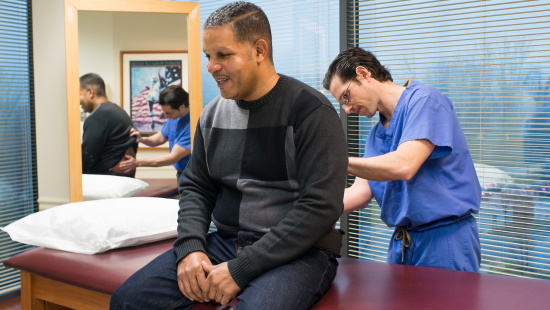Spine Surgery

Debilitating back and neck pain can slow you down and impact your quality of life. And while spine surgery can be a path to relief, the spine specialists of University of Maryland Upper Chesapeake Health take a holistic approach.
Their comprehensive treatment plans take into account your health and lifestyle. We use innovative diagnostics to pinpoint the source of your pain then assess the best course of treatment including surgical and non-surgical options.
Our team, which includes specialists in orthopedics and neurosurgery, uses advanced diagnostic technology as well as old-fashioned listening to discover the cause of your spine pain, which could be caused by a number of underlying conditions.
Find a Spine Surgeon in Harford County
All our spine surgeons are now accepting new patients at these locations.
- Orthopedic Spine Surgery - 800-515-0044 - on the campus of the UM Upper Chesapeake Medical Center Bel Air (UM UCMC Bel Air), convenient to imaging locations and rehabilitation program
Back and Neck Pain Causes
We treat a wide range of spine conditions, including:
Degenerative Disc Disease
Spinal discs act as shock absorbers between the bones of your spine, keeping your back flexible. Degenerative disc disease occurs when your discs break down and are unable to protect your spine.
- Cervical and lumbar disc disease causes lower back pain as the discs begin to break down from wear and tear.
- Spinal stenosis is caused by the narrowing of the spinal canal begins and pinch the spinal cord and the nerves around it, resulting in pain, weakness and numbness.
- Herniated discs happen when the soft center of a spinal disc begins to push through the spinal cord, most often causing pain, weakness and numbness.
- Spondylolisthesis, which is most common in athletes whose sport puts stress on the lower back, is when a vertebra slips out of place.
Pinched Nerve
Pinched nerves can occur when surrounding tissues apply too much pressure to the nerve, causing pain, tingling, numbness and weakness.
- Sciatica causes pain in the lower back that often radiates to the hip and leg due to pressure on the large sciatic nerve.
- Cervical radiculopathy occurs when the nerve root in the cervical spine becomes pinched, inflamed or damaged.
Spinal Deformities
The term spinal deformity refers to conditions that cause an unnatural bend to the spinal column.
- Scoliosis, most common in teenagers, is a curve in the spine that typically often occurs during the growth spurt of puberty. It can result in uneven shoulders and hips, tight muscles and pain.
- Kyphosis is the outward curving of the spine, often related to osteoporosis, which leads to back pain and stiffness.
Types of Spine Surgery
If spine surgery is the right option for you, these are some of the more common procedures our surgeons use to treat debilitating back pain.
- Spinal fusion joins two or more vertebrae. it is most often used for conditions such as scoliosis, spinal arthritis and herniated discs.
- Lumbar decompression aims to improve pain and numbness in the legs caused by compressed nerves.
- Disc replacement involves replacing worn disc material in the spine with a synthetic or "artificial" disc.
Other procedures that they might recommend include:
- Spine laminectomy
- Laminoforaminotomy
- Bone graft alternatives
- Laminoplasty
We've created a video to help you learn more about spine surgery, including how to prepare, what to expect and other helpful information. Watch the video here.
Non-Surgical Back Pain Treatment
Oftentimes, conservative treatments are the first-line approach to managing pain. These may include:
- Medications such as muscle relaxants, NSAIDs (aspirin, ibuprofen), steroids and opiate pain medications
- Pain management
- Acupuncture
- Physical therapy
Live Greater Podcast Episodes
Learn more about spine care, technologies, and treatments from our experts.
